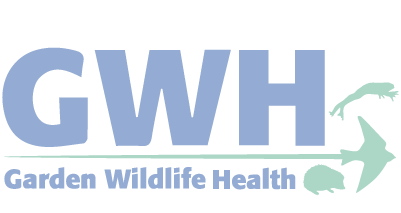Agent
Lucilia bufonivora, commonly known as ‘toad fly’, is a species in the blowfly family (Calliphoridae). Toad fly larvae are parasitic and look similar to other blowfly maggots found on dead animals or rotting meat, being creamy white in colour, and around 10 to 18 mm in length. Adult flies are not parasitic. They resemble house flies, but are slightly larger with a metallic green body similar to green bottle files.
Species affected
Lucilia bufonivora larvae mainly feed on the living flesh of the common toad (Bufo bufo), usually leading to the toad’s death. Other species of toads and frogs can also be affected by the parasite. Adult amphibians are most commonly affected but sub-adults can also be parasitised.
Signs of disease
Affected amphibians may be anorexic, lethargic and depressed. Adult toad flies preferentially lay their eggs on the skin at the entrance of the nostrils of common toads, but can infest other body openings, e.g. the eyes. Larvae then hatch and enter the nostrils where they develop and feed on the local tissues of the living host (myiasis) and may be easily visible. The larvae grow rapidly, the damage to the host is severe and the toad almost always dies as a result of the parasite infestation. It is thought that adult common toads that are already sick or injured are more frequently parasitized than healthy individuals. Adult toad flies may also lay their eggs in wounds of the amphibian host.
Figure 1. Common toad with nasal cavities infested by L. bufonivora (blue arrow)
Image credit: Andrew Breed
Figure 2. Common toad with nasal cavities infested by L. bufonivora (blue arrow)
Image credit: Tariq Stark
A video of an affected and moribund common toad can be seen here: https://twitter.com/Andrew_Breed/status/752874403290083328 (©Andrew Breed)
Disease transmission
Adult toad flies lay their eggs on the skin at the entrance of the nostrils and eyes, or into wounds, of sub-adult and adult toads during the summer months. The larvae then develop and cause disease in the amphibian host.
Distribution
Lucilia bufonivora is commonly found in North West Europe and studies in the Netherlands and Germany have found variable, sometimes high, prevalence of the toad fly infection. This parasite has also been detected in North America (Canada); however, genetic analysis suggests that L. bufonivora has not been recently introduced to the Nearctic, but more likely remained unrecorded due to taxonomic confusion and low abundance.
Whilst this parasitic infection is likely to have a severe impact on affected individuals, there is no evidence to indicate that it affects the species at a population level. The toad fly is thought to be a native (i.e. natural) parasite of the common toad in Great Britain.
Risk to human health
There is no known risk to human health.
Risk to domestic animal health
Lucilia bufonivora has only been found to affect common toads, and on rare occasions other toad and frog species. Therefore, pet amphibians should be regarded as potential hosts of the parasite.
Diagnosis
The appearance of L. bufonivora larvae in the nostrils of a common toad with local tissue damage is highly characteristic and sufficient to make a presumptive diagnosis of ‘toad fly’ parasitism. When fly maggots are present in open wounds, the parasite is likely to be L. bufonivora but could be another blowfly species found in GB.
If you wish to report finding a dead amphibian, or signs of disease in amphibians, please visit www.gardenwildlifehealth.org. Alternatively, if you have further queries or have no internet access, please call the Garden Wildlife Health vets on 0207 449 6685.
Prevention and control
There is no known control or treatment for L. bufonivora larvae infestation in free-living toads.
Further information
More advice on amphibians in your garden can be found on the Garden Wildlife Health website www.gardenwildlifehealth.org or on www.froglife.org.
Scientific publications
Szentivanyi T, Vincze O (2022) Tracking wildlife diseases using community science: an example through toad myiasis. European Journal of Wildlife Research, 68(6) p.1-8. doi.org/10.1007/s10344-022-01623-5
Arias-Robledo G, Wall R, Szpila K, Shpeley D, Whitworth T, Stark T, King RA, Stevens JR (2019) Ecological and geographical speciation in Lucilia bufonivora: The evolution of amphibian obligate parasitism. International Journal for Parasitology: Parasites and Wildlife, 10:218-230. doi.org/10.1016/j.ijppaw.2019.09.005
Arias-Robledo G, Stark T, Wall RL, Steven JR (2018) The toad fly Lucilia bufonivora: its evolutionary status and molecular identification. Medical and Veterinary Entomology. doi.org/10.1111/mve.12328
Mebs D, Petschenka G, Pogoda W, Toennes SW, Amendt J, Zajac BK, Dobler S (2014) Amphibian myiasis. Blowfly larvae (Lucilia bufonivora, Diptera: Calliphoridae) coping with the poisonous skin secretion of the common toad (Bufo bufo). Chemoecology 24(4):159-164. doi.org/10.1007/s00049-014-0157-2
McDonagh LM, Stevens JR (2011) The molecular systematics of blowflies and screwworm flies (Diptera: Calliphoridae) using 28S rRNA, COX1 and EF-1α: insights into the evolution of dipteran parasitism. Parasitology 138(13):1760-1777. doi.org/10.1017/S0031182011001089
Weddeling K, Kordges T (2008) Lucilia bufonivora-Befall (Myiasis) bei Amphibien in Nordrhein-Westfalen–Verbreitung, Wirtsarten, Ökologie und Phänologie. Zeitschrift für Feldherpetologie 15:183-202. http://www.weddeling.info/05-Weddeling_&_Kordges.pdf
Stevens J, Wall R (1997) The evolution of ectoparasitism in the genus Lucilia (Diptera: Calliphoridae). International Journal for Parasitology 27:51–59. doi.org/10.1016/S0020-7519(96)00155-5
Strijbosch H (1980) Mortality in a population of Bufo bufo resulting from the fly Lucilia bufonivora. Oecologia 45(2):285-286. doi.org/10.1007/BF00346472
Acknowledgements
Current funding for the GWH comes in part from Defra, the Welsh Government and the Animal and Plant Agency (APHA) Diseases of Wildlife Scheme (DoWS) http://apha.defra.gov.uk/vet-gateway/surveillance/seg/wildlife.htm; and from the Esmée Fairbairn Foundation, the Universities Federation for Animal Welfare and the Garfield Weston Foundation.
Disclaimer
Disclaimer This fact sheet was produced by Garden Wildlife Health (GWH) for information purposes only. The GWH will not be liable for any loss, damage, cost or expense incurred in or arising by reason of any person relying on information in this factsheet.
Date of factsheet update:


